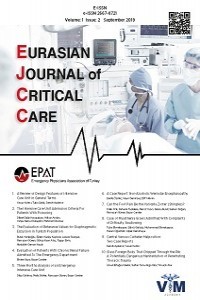D-Dimer Levels and Prognostic Features in Pulmonary Embolism
D-Dimer Levels and Prognostic Features in Pulmonary Embolism
Emergency Medicine, Pulmonary Embolism, D-dimer,
___
- 1. Weitz JI, Fredenburgh JC, Eikelboom JW. A Test in context: D-Dimer. J Am Coll Cardiol 2017;70:2411-2420.
- 2. Keller K, Beule J, Balzer JO, Dippold W. D-Dimer and thrombus burden in acute pulmonary embolism. Am J Emerg Med 2018 ;36:1613-1618.
- 3. Bass AR, Fields KG, Goto R, Turissini G, Dey S, Russell LA. Clinical decision rules for pulmonary embolism in hospitalized patients: a systematic literature review and meta-analysis. Thromb Haemost 2017;117:2176-2185.
- 4. Wakai A, Gleeson A, Winter D. Role of fibrin D-dimer testing in emergency medicine. Emerg Med J 2003;20:319–325.
- 5. Geersing GJ, Janssen KJ, Oudega R, et al. Excluding venous thromboembolism using point of care D-dimer tests in outpatients: a diagnostic meta-analysis. BMJ 2009;339:b2990.
- 6. Farm M, Siddiqui AJ, Onelöv L, et al. Age-adjusted D-dimer cut-off leads to more efficient diagnosis of venous thromboembolism in the emergency department: a comparison of four assays. J Thromb Haemost 2018;16:866-875.
- 7. Carrier M, Righini M, Djurabi RK, et al. VIDAS D-dimer in combination with clinical pre-test probability to rule out pulmonary embolism. A systematic review of management outcome studies. Thromb Haemost 2009;101:886-892. 8. den Exter PL, van Es J, Klok FA, et al. Risk profile and clinical outcome of symptomatic subsegmental acute pulmonary embolism. Blood 2013;122:1144-1149.
- 9. Kabrhel C, Mark Courtney D, Camargo CA Jr, et al. Factors associated with positive D-dimer results in patients evaluated for pulmonary embolism. Acad Emerg Med 2010;17:589-597.
- 10. Righini M, Van Es J, Den Exter PL, et al. Age-adjusted D-dimer cutoff levels to rule out pulmonary embolism: the ADJUST-PE study. JAMA 2014;311:1117-1124.
- 11. Lippi G, Bonfanti L, Saccenti C, Cervellin G. Causes of elevated D-dimer in patients admitted to a large urban emergency department. Eur J Intern Med 2014;25:45-48.
- 12. Akbaş SH, Can M, Kılıçarslan I, Özdem S, Çete Y, Gültekin M. Acil Servise Başvuran Yüksek D-dimer Düzeyli Hastalarda Tanı Dağılımı ve D-dimer Düzeylerinin Hastaneye Yatış ve Ölüm Oranları ile İlişkisi. Turk J Emerg Med 2004;4:149-154.
- 13. Falanga A, Russo L, Milesi V, Vignoli A. Mechanisms and risk factors of thrombosis in cancer. Crit Rev Oncol Hematol. 2017;118:79-83.
- 14. Levitan N, Dowlati A, Remick SC, et al. Rates of initial and recurrent thromboembolic disease among patients with malignancy versus those without malignancy. Risk analysis using Medicare claims data. Medicine 1999;78:285-291.
- 15. Wang S, Zimmermann S, Parikh K, Mansfield AS, Adjei AA. Current Diagnosis and Management of Small-Cell Lung Cancer. Mayo Clin Proc 2019 ;94:1599-1622.
- 16. Stein PD, Gottschalk A, Saltzman HA, Terrin ML. Diagnosis of acute pulmonary embolism in the elderly. J Am Coll Cardiol 1991 ;18:1452-1457.
- 17. Hamatani Y, Nagai T, Nakai M, et al. Elevated plasma d-dimer level is associated with short-term risk of ischemic stroke in patients with acute heart failure. Stroke 2018;49:1737-1740.
- 18. Montaner J, Perea-Gainza M, Delgado P et al. Etiologic diagnosis of ischemic stroke subtypes with plasma biomarkers. Stroke 2008;39:2280-2287.
- 19. Folsom AR, Gottesman RF, Appiah D, Shahar E, Mosley TH. Plasma d-dimer and incident ischemic stroke and coronary heart disease: the atherosclerosis risk in communities study. Stroke 2016;47:18-23.
- 20. Lindner G, Funk GC, Pfortmueller CA, et al. D-dimer to rule out pulmonary embolism in renal insufficiency. Am J Med 2014 ;127:343-347.
- 21. Kovac M, Mikovic Z, Rakicevic L, et al. The use of d-dimer with new cutoff can be useful in diagnosis of venous thromboembolism in pregnancy. Eur J Obstet Gynecol Reprod Biol. 2010;148:27-30.
- 22. Gutiérrez García I, Pérez Cañadas P, Martínez Uriarte J, et al. D-dimer during pregnancy: establishing trimester-specific reference intervals. Scand J Clin Lab Invest 2018;78:439-442.
- Başlangıç: 2019
- Yayıncı: Acil Tıp Uzmanları Derneği
Bahadir TASLİDERE, Ertan SONMEZ, Ayse KARATAS, Begüm SAKIN, Rümeyza KAZANCIOĞLU
Ayça ÇALBAY, Atıf BAYRAMOĞLU, Erdem KARADENİZ
Evaluation of Nursing Home Residents Applying to The Emergency Service
Ali İhsan KİLCİ, Hakan HAKKOYMAZ, Muhammed Semih GEDİK, Levent AVSAROGULLARİ, Vesile ŞENOL, Mükerrem ALTUNTAŞ
D-Dimer Levels and Prognostic Features in Pulmonary Embolism
Burak KURTOĞLU, Halil İbrahim ÇIKRIKLAR, Vahide Aslıhan DURAK, Issa OMAR, Ahmet Münir YILMAZ, Sümeyye Tuğba SARKI CANDER, Erol ARMAGAN
Bibliometric Analysis of Studies on Mean Platelet Volume (MPV) in the Web of Science Database
Hasan GÜMÜŞBOĞA, Muhammet Esat KARADUMAN, Ceren KARAKEÇİLİ, Mustafa BOĞAN
The Influence of the COVID‑19 Pandemic on Pediatric Head Trauma
Central Pontine Myelinolysis as a Result of Ideally Corrected Hyponatremia in a Post-Covid Patient
Julide GURBUZ, Bahadir TASLİDERE, Ahmet EMİN, Ertan SONMEZ
Causes and Outcomes of Childhood Trauma with GCS Below 9
Changiz GHOLİPOURİ, Samad SHAMS VAHDATİ, Parham MAROUFİ, Aytak KHABBAZ, Naeimeh HOSSEİNZADEH, Pouya ABBASGHOLİZADEH
